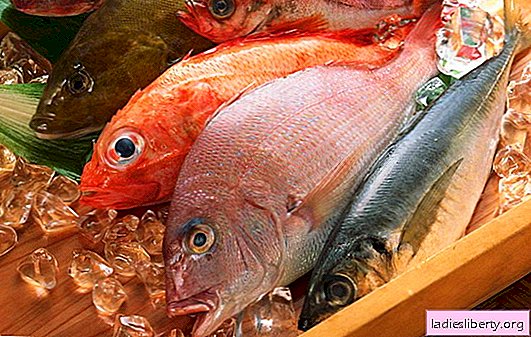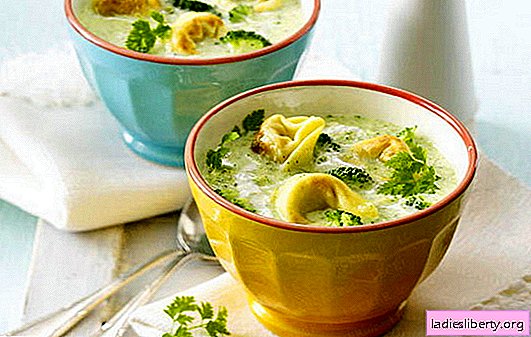
Nori is a gift of the sea no worse than the well-known seaweed, exotic in the kitchen and possessing effective properties for improving health and even losing weight. But for this product to taste, it is also important to be able to choose it correctly.
Nori marine origin and product selection features
Nori is a word with more than one meaning, which is usually called, firstly, several edible varieties of red algae of the genus Porfira, and secondly, products made from them.
Nori - one of the main ingredients of Japanese cuisine, which has gained popularity thanks to sushi - these are the very dark green sheets in which the rolls are wrapped.
Japanese nori culinary specialists have been known for many centuries, but only in the second half of the 17th century did algae change from a pasty state to the form of a leaf known to us today.
In Korea, nori is known as kim, but the local product differs from sweet Japanese algae in a more pronounced, brackish taste.
The process of creating a nori is time-consuming and multi-stage - algae are washed, crushed, pressed and dried, but after all - they retain their nutritional and beneficial properties.
Their taste is neutral, in harmony with many products, a bit like cabbage.
Products from these algae are usually divided into three varieties:
• Nori-maki - designed for sushi and other dishes, including rice. Their obligatory form is a square or rectangular small sheet (usually with sides up to 25 cm), the two sides of which are different - it is supposed to lay the filling on a slightly rough and matte (spread the plate on a special mat for making rolls), while it remains smooth and glossy outside, creating an appetizing appearance of the dish;
• Ava-nori - These are the powdered waste products from the production of nori plates for rolls (named above), used as a seasoning for a variety of dishes, including noodles, snacks, sauces, soups and side dishes;
• Yaki-nori - look like classic nori sheets, but differ from them in that they underwent heat treatment (frying), enhancing their taste and aroma. Usually they prepare salads, snacks and main dishes, as well as broths, the basis for soups.
The division of nori into three (sometimes four) varieties also means a lot:
• Gold or A is the only variety truly suited to good rolls. Each sheet has smooth edges, strength combined with elasticity, does not break when bent. The texture of the sheet is homogeneous, without gaps, the color may have a beautiful golden hue. Often this variety smells attractive to the sea;
• Solver or B, Green and Red or C - have an order of magnitude worse quality than the first grade and are suitable for dishes where the Nori’s appearance is not so important - these algae plates bend poorly and crack easily, their texture may include gaps, and in green faded and reddish tones may be present. Gourmets also note slightly worse taste qualities of these varieties.
The high energy value of nori - 349 kcal per 100 g, is compensated by their lightness - one sheet weighs just a few grams.
In the traditional medicine of Japan and China, nori has always been famous as a means of prolonging youth, and modern science largely agrees with this ancient statement, and also it, with each new study, tends to increase the value of nori more and more.
What elements of the composition especially affect the benefits of nori
In vegetarian cuisine, nori is known as one of the main plant sources of cobalamin - a bioavailable form of vitamin B12, which is necessary for all human life systems, the main sources of which are also meat and eggs.
In addition, nori is a significant source of iodine, which positively affects the health of the thyroid gland.
And, not being a fish, these algae are still valuable as a source of omega-3 fatty acids - powerful antioxidants that prevent premature aging of the body and weakened immunity.
Polyunsaturated acids, along with complex carbohydrates, are also an energy source for the activity of the entire nervous system and brain, so nori can be recommended to mental workers and students to improve memory and concentration.
The list of positive properties of Omega-3 can be continued further, they, in particular:
• lower the level of "bad" cholesterol;
• make the walls of blood vessels and capillaries stronger;
• the above and other effects reduce the risks of developing cardiovascular diseases (including heart attack and varicose veins);
• normalize the production of essential enzymes in the body;
• positively affect blood formation processes.
The high content of a particular protein gives Nori exceptional health benefits for the entire musculoskeletal system, and it is also worth noting the importance of calcium, phosphorus and magnesium for muscles and bones - there are plenty of them in nori.
Vitamins A and E are necessary for eye health - from the protection of eyesight under everyday stresses (which include, in particular, the wearing of improperly selected contact lenses and prolonged computer work) to the prevention of age-related negative changes in the retina at the cellular level.
Individual elements of the chemical composition of nori are distinguished by bright anti-inflammatory and regenerative properties, due to which these algae can be useful to reduce the risks of developing gastritis and gastric ulcer.
What are the benefits of nori for weight loss and beauty?
A diet designed for weight loss is beneficial only for healthy digestion, and in this regard, nori means a lot in a number of properties, algae, in particular:
• accelerate the digestion of food and the removal from the body of its processed residues due to the high content of dietary fiber;
• contribute to the rapid breakdown of fats (nori are equivalent to pineapple in this property);
• increase the digestibility of nutritious, useful substances from any products (which is especially valuable when the menu is reduced in volume and range for weight loss);
• create a prolonged feeling of satiety (even if something completely light was eaten with nori);
• again, due to fiber - effectively cleanse the body of toxins and radionuclides;
• support the vital activity of beneficial intestinal microflora.
Despite the fact that nori are not the very algae that are commonly used in the manufacture of cosmetics and for beauty salons, they also, simply when consumed with food, have a positive effect on appearance:
• accelerate cell metabolism and increase the sensitivity of the epidermis to incoming substances (for example, with creams and masks);
• toning the skin and smoothing small wrinkles;
• stimulating (albeit slightly) the production of collagen and elastin.
Can nori do harm
Since nori are seafood, they should be used with caution by pregnant women and young children, in order to avoid harm to nori in the form of negative effects on the body of salts of heavy metals (and other harmful substances), unfortunately, often, as a result of environmental pollution, accumulating in seafood.
Despite the fact that nori do not belong to highly allergenic products, a negative reaction to these products may occur with individual intolerance to iodine.
Although, theoretically, this is unlikely - in terms of the content of this microelement, nori is significantly inferior to other algae.
There will definitely be harm from nori with excessive consumption of seafood - this is fraught with metabolic disorders and problems with the functioning of the digestive tract. Also, nori can worsen the condition with existing inflammatory diseases of the stomach.











